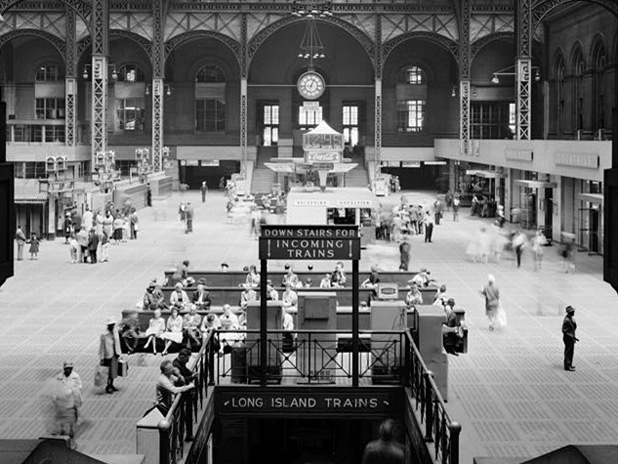It’s hard to believe that Manhattan’s Pennsylvania Station was once a masterpiece of pink granite, marble columns, and arched-glass windows.
In 1963, the above-ground portion of the station was demolished to make room for a massive sports arena, Madison Square Garden. Its reputation as an architectural masterpiece quickly faded. And most recently several incidents have boosted the station’s reputation as a subterranean hellscape.
A train derailment in April that spawned mass cancellations outraged travelers. Later in the month, stampedes and false rumors of an active shooter rippled through Penn after police tased a man. Then, in early May, foul-smelling sewage water rained down on commuters from the ceiling.
Amtrak’s long overdue rail repairs threaten to worsen a headache for the 650,000 people who travel through Penn Station each day.
But things were not always this bad.
Take a look at these photos of the original Penn Station, one of the last structures of neo-classical architecture in New York City, before it was torn down.
The original Pennsylvania Station stood from 1910 until its destruction in 1963.
The station was named for the now-defunct Pennsylvania Railroad, the company that built it. For that same reason, there are also Pennsylvania Stations in cities like Newark and Baltimore.

Construction on the Beaux-Arts-style marvel began in 1901 and took nine years to complete. It was designed by the renowned architectural firm McKim, Mead & White, which also built Columbia University's campus.
The designers envisioned the station as the “entrance to one of the great metropolitan cities of the world.”

Source: Columbia University
The station spanned two city blocks, stretching from Seventh to Eighth Avenue between 31st Street and 33rd Street.

Source: "Passenger Terminals and Trains" by John Albert Droege
The Roman Baths of Caracalla inspired the building's classical design. Just look at those arched windows and Corinthian columns.

By the 1920s, two thirds of the station's daily passengers were commuters from the suburbs.

Source: PBS
The station also had trains heading out to Chicago and St. Louis.

Like today, the old Penn Station was a chaotic transport hub at times.

Here's a shot of the holiday rush in 1951.

But instead of slogging through smelly underground tunnels, travelers got to walk through beautiful, sunlit spaces like this waiting room.
Part of the building's iconic ceiling was made from glass and wrought-iron.

The giant clock in the Great Gate room kept travelers on time.

In the main waiting room, a bronze statue of Pennsylvania Railroad president Alexander Johnston Cassatt watched over travelers.

In the 1930s, a Greyhound bus station also popped up around the station.

Railroad travel peaked during WWII, and Penn Station was no exception to that surge. But by the 1950s, travel had declined and the station became derelict and grimy due to neglect and the Pennsylvania Railroad's financial woes.

Source: American Rails
The Pennsylvania Railroad ended up optioning the station's air rights in the 1950s. The above-ground structures would be replaced by Madison Square Garden, while the underground portion of the station would remain.

Sources: Mashable, NYC Architecture
The new developments caught the public off guard in 1961, when the news appeared in the New York Times. Protests were mounted against the destruction of the landmark building, but the demolition proceeded in October 1963.

Source: The New York Times
"Until the first blow fell, no one was convinced that Penn Station really would be demolished, or that New York would permit this monumental act of vandalism against one of the largest and finest landmarks of its age of Roman elegance," wrote the New York Times's editorial board.

Sources: "Rubble: Unearthing the History of Demolition" by Jeff Byles, The New York Times, Life Without Buildings, NYC Architecture
"We will probably be judged not by the monuments we build but by those we have destroyed," the New York Times's editorial board wrote on October 30, 1963.

Source: The New York Times
Today, only remnants of the old Penn Station structure survive, like this eagle statue.

Sources: NYC Architecture, Museum of the City of New York
The demolition of the landmark train station ended up being one of the defining moments in the history of architectural preservation in the US. Two years after Penn Station was razed, New York City founded its Landmarks Preservation Commission.

Source: Museum of the City of New York
That preservation committee went on to help maintain Grand Central's majestic look, which now stands in direct opposition to the modern iteration of Penn Station. As New York Times architecture critic Michael Kimmelman writes, "To pass through Grand Central Terminal, one of New York’s exalted public spaces, is an ennobling experience, a gift. To commute via the bowels of Penn Station, just a few blocks away, is a humiliation."

Source: The New York Times
In the decades since the demolition, Penn Station's usage has increased once more. The New York Times estimates that Penn Station is the busiest transit hub in the Western world — busier than Heathrow Airport in London and Newark, La Guardia, and Kennedy airports in the New York City metro area combined.

Source: The New York Times
To this day, many people lament the destruction of the once-great Manhattan transport hub. As Yale professor Vincent Scully, Jr. told the New York Times in 2012, “One entered the city like a god; one scuttles in now like a rat.”

